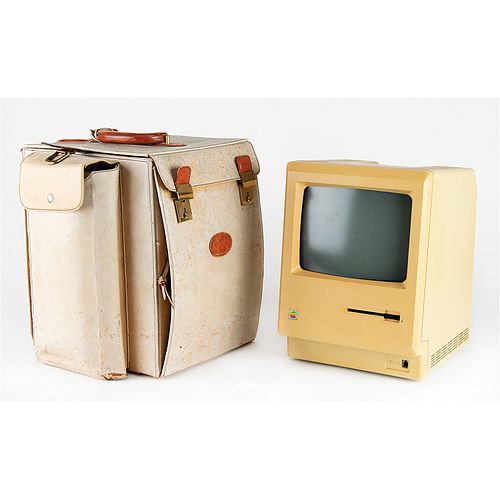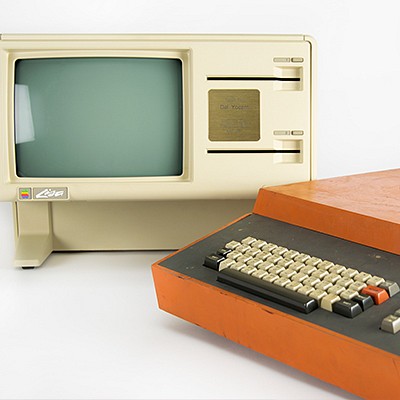Macintosh 128K Prototype Computer with Display Case and Accessories
Two ways to bid:
- Leave a max absentee bid and the platform will bid on your behalf up to your maximum bid during the live auction.
- Bid live during the auction and your bids will be submitted real-time to the auctioneer.
Bid Increments
| Price | Bid Increment |
|---|---|
| $0 | $5 |
| $50 | $10 |
| $200 | $25 |
| $500 | $50 |
About Auction
Mar 16, 2023
RR Auction support@rrauction.com
- Lot Description
Historic prototype/pre-production Macintosh 128K computer, with a rare custom hand-crafted leather carrying case, evidently commissioned by Steve Jobs or provided as a sample of work—a small number of these cases are known to have been given to key employees on the Macintosh project. In this instance, the consignor notes that the computer and case were gifted by Joanna Hoffman, one of the original members of the Macintosh team (and, later, an original member of the NeXT team); they had become friends at MIT and had developed Macintosh software together.
The case has a pocket on the side which holds the included prototype/pre-production Apple M0110 mechanical keyboard, which lacks the standard barcode label on the bottom, instead bearing a simple label identifying it as "Model Number M0110, Serial Number 1362." Attached to the case's handle are two skeleton-style keys for the dual locking latches.
The Macintosh 128K does not have a standard Apple serial number or barcode, instead bearing a simple red-bordered label numbered "A1454." The rear label differs slightly from the retail version, lacking some warning/caution emblems and trademark text. The bottom of the case also bears a different vent layout than the retail version of the computer; it was evidently created before the venting and cooling system was finalized. Rather than use an inelegant cooling fan, Steve Jobs insisted that the Macintosh rely on convective heat transfer, which made it quiet while in operation.
Like the retail version of the computer, this prototype has the facsimile signatures of the Macintosh team—including Steve Jobs, Daniel Kottke, Jef Raskin, Steve Wozniak, Andy Hertzfeld, and Joanna Hoffman—stamped inside the plastic case. Inside, the analog board is marked "C039" on the top edge, and the logic board, dated 1983, is marked "C023" on the edge near the mouse connector. The logic board appears nearly identical to the retail version, with two exceptions: an area populated with a red LED bulb, and a unique 512 EPROM adapter board plugged into the LOW and HIGH ROM sockets.
The analog board exhibits some corrosion and its capacitors show some signs of component failure and should be replaced. The logic board is cosmetically fine. The system was examined and tested by Steven Matarazzo (aka Mac84), who, after troubleshooting some error codes, managed to successfully boot up the Macintosh; however, the monitor displayed some video stability issues and there may be memory or software issues that result in 'Sad Mac' errors. He determined that there are no catastrophic issues with the machine, and a skilled technician could restore it to complete functionality. His detailed technical report accompanies the lot. Additionally includes retail versions of the Apple M0100 Mouse, Apple M0130 External Disk Drive, Apple M0120 External Numeric Keypad, and sealed manuals for MacCalc and MacPaint.
The Macintosh 128K was the first in the line of Apple's Macintosh computers. It offered a radically new approach which featured a graphical user interface (GUI), built-in screen, and mouse-all of which revolutionized the user's experience, marking the transition from command-line computing to a point-and-click model. The Macintosh was famously announced in one of the most-viewed Super Bowl advertisements of all time, '1984.' This significant, early pre-production example of the first Macintosh—paired with its rare leather carrying case—provides remarkable insight into Apple's revolutionary computer. - Shipping Info
-
Bidder is liable for shipping and handling and providing accurate information as to shipping or delivery locations and arranging for such. RR Auction is unable to combine purchases from other auctions or affiliates into one package for shipping purposes. Lots won will be shipped in a commercially reasonable time after payment in good funds for the merchandise and the shipping fees are received or credit extended, except when third-party shipment occurs. Bidder agrees that service and handling charges related to shipping items which are not pre-paid may be charged to a credit card on file with RR Auction. Successful international Bidders shall provide written shipping instructions, including specified Customs declarations, to RR Auction for any lots to be delivered outside of the United States. NOTE: Declaration value shall be the item’(s) hammer price and RR Auction shall use the correct harmonized code for the lot. Domestic Bidders on lots designated for third-party shipment must designate the common carrier, accept risk of loss, and prepay shipping costs.
-
- Buyer's Premium



 EUR
EUR CAD
CAD AUD
AUD GBP
GBP MXN
MXN HKD
HKD CNY
CNY MYR
MYR SEK
SEK SGD
SGD CHF
CHF THB
THB















